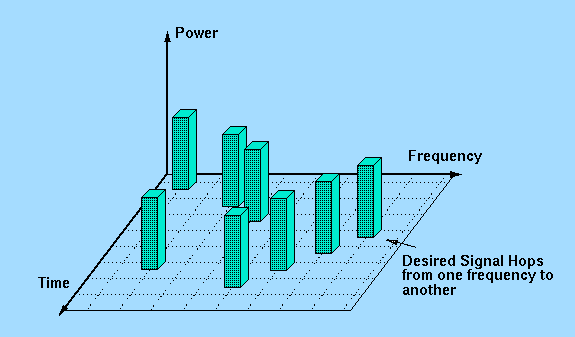
 |
JPL's Wireless Communication Reference WebsiteChapter: Analog and Digital Transmission
|
In frequency hopping systems, the transmitter changes the carrier frequency according to a certain "hopping" pattern . The advantage is that the signal sees a different channel and a different set of interfering signals during each hop. This avoids the problem of failing communication at a particular frequency, because of a fade or a particular interferer.

As nearby hopping interferers are unlikely to continuously transmit in the same frequency slot as the reference user, the near-far problem is less severe than in direct sequence (DS) CDMA. Particularly for wireless LANs, where terminals can be located anywhere, this advantage made SFH popular.
Evaluation of Direct Sequence and Frequency Hopping shows that both of those techniques have their specific advantages and disadvantages. Direct Sequence on one hand suffers heavily from the Near-Far effect, which makes this technique hard to apply in systems without the ability of power control. On the other hand, its implementation is inexpensive. The pn-code generators are easy to implement and the spreading operation itself can be simply performed by exor-ports. Frequency Hopping effectively suppresses the Near-Far effect and reduces the need for power control. However, implementation of the (fast) hopping frequency-synthesizer required for a reasonable spreading gain is more problematic in terms of higher silicon cost and an increased power consumption.
Applying both techniques allows for combining their advantages while disadvantages can be reduced. This results in a reasonable Near-Far resistance at an acceptable hardware cost.
When designing an hybrid system, the designer should make the choice of applying either Fast or Slow Frequency Hopping. Fast Frequency Hopping increases the cost of the frequency synthesizer but provides more protection against the Near-Far effect. Slow Frequency Hopping combines a less expensive syntheziser with a worse Near-Far rejection and the need for a more powerfull error correction scheme (several symbols are lost during a ``hit'').
These and other trade-offs that play a role in the definition of a hybrid Direct Sequence - Frequency Hopping communication system are illustrated in the WISSCE case study. It also covers a derivation of the BER of a DS/FH CDMA System employing MFSK Modulation.